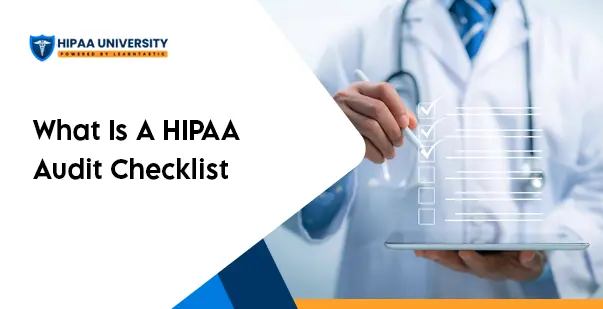What Is A HIPAA Audit Checklist?

August 26, 2024
Every healthcare organization that handles patient information has one big job: keeping that data safe. And to stay on the right side of the law, they need more than good intentions—they need structure. That’s where a HIPAA audit checklist comes in.
This checklist isn’t just paperwork. It’s a working guide that helps teams align with the Health Insurance Portability and Accountability Act (HIPAA). It walks through everything from physical security to digital safeguards and helps spot weak spots before they become violations.
What Goes Into a HIPAA Audit Checklist?
A proper audit checklist covers several areas of a healthcare operation. Think of it like a layered defense—physical, digital, and administrative. Here’s how it breaks down:
Administrative Safeguards
Risk Analysis
You need a clear process for identifying risks to your systems and data—especially anything involving electronic Protected Health Information (ePHI). That means checking what could go wrong and showing what you’re doing to fix it.
Policies and Procedures
If your security policies are collecting dust, it’s time to update them. These should reflect how your organization actually operates—not just what sounds good on paper.
Training
HIPAA training isn’t a one-time thing. Staff need regular refreshers so they understand what’s expected and what to do when something feels off.
Incident Response Plan
If there’s a breach, what’s your move? A real plan—not just a vague document—should be in place to respond, notify, and recover.
2. Physical Safeguards
Who Has Access
Not everyone needs to be near sensitive data. Your audit should confirm that only authorized personnel can physically access rooms, servers, or systems that store ePHI.
Workstation and Device Security
Laptops, desktops, tablets—they should all be protected when left unattended. That includes auto-locks, secure locations, and clear policies for use.
Disposal and Reuse
Before reusing or tossing out devices that once held patient data, make sure they’re properly wiped or destroyed. It’s a small step that prevents a big mistake.
3. Technical Safeguards
Access Controls
Everyone accessing ePHI should have their own login—and it shouldn’t be something easy to guess. Audit tools should also be in place to monitor who’s doing what.
System Monitoring
Logs should be active and reviewed. If someone tries to tamper with records or snoop where they shouldn’t, your system should be able to flag it.
Protecting Data Integrity
Make sure data can’t be altered without authorization. Encryption and system checks help ensure that what goes in isn’t silently changed or deleted.
Secure Transmission
Data sent over networks must be encrypted. If someone’s emailing or uploading files that contain ePHI, there should be safeguards that keep it secure in transit.
4. Privacy Rule Compliance
Patient Rights
Patients have the right to access, correct, or limit how their Protected Health Information (PHI) is used. Your audit should confirm that these rights are being communicated and respected.
Consent and Authorization
You can’t share PHI for marketing or non-treatment purposes without permission. Make sure your forms are current and complete.
Privacy Notices
The notice patients receive about how their data is used needs to be up to date, easy to understand, and available whenever someone asks.
5. Documentation
Policies and Protocols
All security policies, procedures, and risk assessments should be written down and easily accessible. If you can’t show it, it doesn’t count.
Training Logs
Keep records of who was trained, when, and on what. That includes onboarding and any periodic updates.
Assessment Records
If you’ve run risk assessments or responded to incidents, document the findings and how they were addressed.
6. Business Associate Agreements (BAAs)
Vendor Contracts
Anyone outside your organization who handles ePHI must have a signed Business Associate Agreement. This isn’t optional.
Ongoing Monitoring
Don’t stop at the signature. Check in on your vendors’ practices and make sure they’re doing what the agreement says they will.
7. Breach Reporting
Response Policy
You should have a clear policy outlining what to do if there’s a breach—who’s notified, how soon, and what steps are taken to contain the issue.
Incident Logs
Any suspected or confirmed incident needs to be logged. That includes what happened, when, and what you did about it.
8. Internal and External Audits
Internal Checks
Don’t wait for an outside agency to show up. Run your own audits regularly to catch issues early.
Audit Readiness
All of your documentation, training, and risk management efforts should be easy to access and organized. If a regulator visits tomorrow, you should be ready.
🔗 Read More: Is Microsoft Teams HIPAA Compliant?
Why a HIPAA Audit Checklist Really Matters for Data Protection
Ask anyone who’s been through a HIPAA audit—the checklist isn’t just paperwork. It’s one of the most practical tools you have for keeping patient information safe and proving you’re doing things by the book. Here’s how it helps:
It Keeps You on the Right Side of Compliance
The checklist walks you through HIPAA’s requirements step by step, especially the Security Rule. It helps make sure your policies, access controls, and risk management practices aren’t just theoretical—they’re actually in place.
It Flags Weak Spots Early
Every organization has blind spots. The checklist helps you find them—gaps in encryption, outdated training, inconsistent enforcement—before they turn into real problems or regulatory penalties.
It Raises the Bar on Security
A well-used checklist pushes you to keep improving. From physical safeguards to how data moves across networks, it gives you a framework to tighten controls and reduce exposure.
It Shows Your Work
If regulators come calling—or even if a partner asks—you need more than good intentions. The checklist creates a paper trail that shows exactly what you’ve done to meet HIPAA standards and protect Protected Health Information (PHI).
It Makes Audits Manageable
Audits are stressful. But when you’ve already been using a checklist to stay organized, you’re not scrambling. It tells you what to check, where to look, and what needs to be ready.
It Keeps You Moving Forward
Threats change. Technology changes. The checklist helps you spot what needs updating and gives you a reason to keep evolving—not just reacting when something breaks.
It Highlights Where Staff Need Support
Sometimes the problem isn’t the policy—it’s that people don’t understand it. If the checklist shows repeated gaps tied to staff behavior, it’s a cue to reinforce training or clarify expectations.
It Strengthens Your Breach Response
When something goes wrong, time matters. The checklist helps confirm that your incident response plan isn’t just theoretical—it’s clear, accessible, and ready to go.
Where Organizations Often Slip During HIPAA Audits
Even teams that try to stay compliant run into trouble during HIPAA audits. It’s rarely a single failure—it’s usually a mix of outdated processes, inconsistent follow-through, and missing documentation. Below are some of the common mistakes auditors tend to find:
Incomplete or Disorganized Documentation
A recurring issue in audits is a lack of supporting records. Policies may exist but aren’t updated. Training logs might be scattered or missing. And access logs? Often not maintained regularly.
Risk Assessments That Don’t Reflect Reality
Risk assessments should evolve with your systems and workflows. Too often, they’re done once, filed away, and never revisited—leaving new vulnerabilities completely unchecked.
Training That Doesn’t Stick
Initial HIPAA training might be in place, but that’s not enough. Staff need updates, especially when roles change or new systems are introduced. Training that’s too generic—or undocumented—is a red flag.
Policies That Aren’t Put Into Practice
Having policies on paper isn’t the same as using them. During audits, it’s common to find procedures that exist in theory but aren’t being followed day to day.
Access Controls That Are Too Loose
If users have more access than they need—or if accounts aren’t properly managed—sensitive data is exposed to unnecessary risk. HIPAA expects access to be limited, traceable, and enforced.
Breach Response That Lacks Clarity
A security incident should trigger a clear, fast response. But some organizations don’t have a tested plan, or worse, fail to recognize and report incidents in time.
Weak Spots in Physical and Technical Security
From unlocked laptops to unencrypted backups, basic safeguards are often missed. HIPAA looks closely at how physical devices and digital systems are secured.
Vendor Agreements That Fall Through the Cracks
Anyone handling your ePHI must have a valid, current Business Associate Agreement (BAA) in place. This is often missed or neglected during vendor onboarding.
Privacy Notices That Don’t Hold Up
Patients have a right to understand how their data is used. Outdated or incomplete privacy notices—and missing consent or authorization—can seriously hurt your audit outcome.
Skipping Internal Reviews
Many organizations wait for an external audit to evaluate their HIPAA compliance. That’s risky. Regular internal audits are essential for catching issues early and staying audit-ready.
🔗 Read More: What Is The Purpose of HIPAA in 2024?
In Closing
A HIPAA audit checklist isn’t just a helpful tool—it’s one of the strongest ways to protect patient data and prove your commitment to compliance. It forces you to look closely at how your systems work, how your people are trained, and where risks may be hiding.
It’s not about perfection. It’s about being ready—ready to prevent mistakes, ready to respond if they happen, and ready to show that protecting Protected Health Information (PHI) is more than just a policy—it’s part of your culture.





